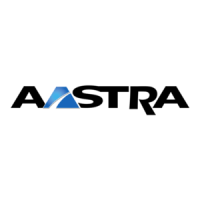System interfaces
40
System functions and features as of R3.0
syd-0367/1.3 – R3.0 – 03.2013
Format of the ETSI S-bus
The format on the ETSI S-bus can be configured in the interface configuration for
each BRI-S interface.
Tab. 9 System configuration: Format of the ETSI S-bus
Exchange Access Prefix for Terminals on the ETSI S Bus
For terminals on the ETSI S-bus the interface configuration can be used to select
whether or not the exchange access prefix of the CLIP should be truncated for in-
coming calls (setting Remove exchange access prefix, default setting = No"). This set-
ting is effective only in the S-bus mode (S bus protocol =ETSI).
Aastra Intelligent Net:
In an AIN the call charge format of ISDN terminals depends on the coun-
try and is based on the country configured with the region of the node
concerned or user. User allocation takes priority over a node-specific allo-
cation.
Voice and data terminals on the BRI-S interface
Both voice and data terminals can be connected to the same BRI-S interface. When
designing the system, bear in mind that data terminals can also take up user infor-
mation channels. ISDN routers and ISDN PC cards that support channel bundling
can take up both user information channels.
In mixed operation the availability of the terminals has to be taken into account.
One call or data connection can be set up on each bearer channel (B channel) si-
multaneously and independently of the other B channel.
Parameter Parameter value Remarks
MSN format on the S-
bus
• Terminal selection
digit (TSD)
• A single digit number is used to address the terminals.
• User number • Default setting
• Mode of operation as customary in the public ISDN network
• DDI number • For special applications (e.g. Unified Messaging Systems).
• If the DDI number is missing, the system attempts to trans-
mit one of the following numbers, in the sequence shown
below: Number of the CDE, UG number, user number.
• Also functions internally.

